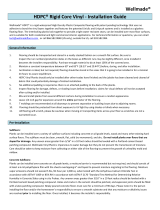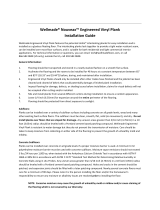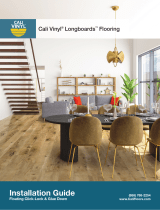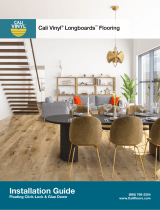
Linkoor Supreme
Supreme_1L’Antic Colonial, S.A.U. Ctra. Nacional 340, Km.54_12540_Vila-Real (Castellón) España_www.anticcolonial.com ED2_JRS_01/07/23
I. GENERAL INFORMATION
These installation instructions only refer to vinyl flooring. All of the
advice is based on the latest technical information.
The information given in these installation instructions follows general
standards. All instructions and advice should be followed to ensure
the correct and satisfactory installation of the flooring. Vinyl flooring
may only be stored and installed in interior spaces with a stable clima-
te in which an ambient temperature of at least 18ºC and a maximum
of 29ºC must prevail. Temperature above or below the above mentio-
ned levels may cause damage to the floor. Relative humidity should
remain between 40 and 65% during installation. Temperatures above
or below the aforementioned levels may damage the flooring. The
maximum relative humidity should not exceed 65% during installa-
tion. Before installing it, carefully check that the product has not been
dama- ged during transportation and we recommend checking the
color, design, quantity, dimensions and appearance against the orde-
red product and for any visible defects, prior to installation. Damaged
material will never be replaced once installed. Some differences in the
color and structure are due to the very nature of the material, so they
cannot be the subject of any claim.
The technical data sheet of the product, which can be checked on the
website www.anticcolonial.com, cannot reflect all the applications
and conditions involved in the use of a material, so in case of situati-
ons not described in the data sheet, it is recommended to consult our
technical department.
Materials with different shades/production batches cannot be mixed,
unless expressly approved by L‘Antic Colonial. Check that all the mate-
rial comes from the same collection and is made in the same batch.
II. PREPARATION
1. Store and transport your vinyl flooring in a way that prevents any
deformation; always keep it on a flat surface. The vinyl flooring can
only be stored and installed in indoor areas. Never store the boxes
vertically or in a damp environment, in rooms with dust, places with
extreme temperatures or exposed to drafts. Store the material in a
horizontal position, without resting it against walls, laying it flat on
strips or on the pallet, and 0.5 m away from any walls. It is essential
to let your flooring acclimate to the room in which it is going to be
installed, for at least 48 hours prior to installation, at a temperature
between18ºC and 29ºC. It is necessary to maintain the same tem-
perature before, during and for at least 72 hours after completing
the installation.
Always start installing on an empty surface to prevent the vinyl
boards from being damaged by tools, etc. before, during and after
installation.
Combining pieces from at least 3 different boxes during installation
will help to ensure an even distribution of any minor variations in
color or slight variations in texture and brightness levels. Please bear
in mind that the uniformity of the color of the boards can only be
guaranteed for boards from the same shade.
No claims can be made for boards that have already been cut or
installed.
2. The type, quality and preparation of the subfloor largely determi
ne the end result of the installation. Appropriate steps should be
taken if the floor is not suitable for installing the vinyl flooring, as any
unevenness in the subfloor may leave marks on the vinyl floo- ring
and damage the machined profile of the joint between pieces. It is
advisable only to install the floor covering when the building is free
from any risk of water damage (i.e. when the exterior walls, doors,
windows and roofs have been installed), when the necessary mea-
surements have been taken of the support layers and any additional
work has been completed.
Remove any existing floor covering; there should be no signs of mold
or insect infestations; make sure that the subfloor is even. As a general
rule, the subfloor where the flooring is going to be installed must be
compact, solid, flat, stable, non-deformable, dry, free of rising damp,
without cracks, clean and free of substances that are not perfectly
anchored and dust. If necessary, apply a leveling compound on top to
achieve a smooth, even and fully prepared floor.
3. Make sure that the subfloor is completely even. You must correct
any unevenness exceeding 2 mm that is greater than 1 m long, and
any unevenness exceeding 3 mm that is greater than 2 m long.
Vertical surface unevenness exceeding 1.2 mm is not permitted.
The subfloor should not slope more than 25mm per 2 meters in any
direction. Use a suitable leveling compound and check if a sealer or
primer is required. It is essential to correct any imperfections and
cracks on the surface.
4. The vinyl flooring should not be screwed in or fixed to the floor in
any way. Avoid placing heavy furniture on the flooring that would
impede the normal movement of the floating floor.
5. You must take into account the building’s joints; a transition profile
can be used to place a joint in the flooring.
6. The subfloor’s humidity should be no greater than 2.5% CM
(cement) or 0.5% (anhydrite).
Make sure that the subfloor is completely dry, smooth, stable, clean
and free of grease and chemical stains. All touch-up work on the
subfloor should be performed using a mixture of non-shrink and
waterproof cement. Work in accordance with UNE EN:14472.
7. Always install all of the boards parallel to the room’s main light sou-
rce. It should only be installed lengthwise in long and narrow rooms.
8. Check all of the panels before and during installation in optimal
lighting conditions.
9. Necessary tools: knife or cutting disc for wood, tapping block, pull
bar, spacers, tape measure, pencil, white rubber mallet or hammer, spi-
rit level, block of nylon if necessary, tools for preparing the base floor.
III. SUBFLOOR INFORMATION
Although a floating vinyl floor is installed, careful preparation of the
base floor helps to ensure a satisfactory installation. Rough or uneven
areas in the subfloor can be transferred to the newly- installed vinyl
flooring, put pressure on it and lead to breakages, the loosening of
joints, buckling, warping, noise when walking on it and an unsightly
overall appearance.
Do not install it on a floating floor.
Wooden base floors:
Vinyl boards should not be installed on wooden base floors that lie
directly on cement or beam constructions.
All wooden or wood composite panels are suitable as base floors for
vinyl boards, provided that they are smooth, flat, structurally sound
and free of buckling.
Plywood panels, particle boards and oriented strand boards (OSB) are
suitable. Make sure that they are properly secured to avoid any annoy-
ing noise when walking on them. Fibreboards such as MDF or HDF
have very strong water absorption power and are not recommended
for use in commercial areas. Make sure that the subfloor on which you
lay vinyl flooring maintains stable conditions.
Cement base floors:
Cement base floors should be smooth, dry and free of dust, liquids,
paint, wax, grease, oil, sealant and other foreign materials. The surface
should be hard and sealed and free of dusty or flaking areas. New
cement floors should be completely dry (drying time at least 6 weeks)
1. 2.
7.6.
4. 5.3.
10mm
10mm
INSTALLATION INSTRUCTIONS
EN

Supreme_2L’Antic Colonial, S.A.U. Ctra. Nacional 340, Km.54_12540_Vila-Real (Castellón) España_www.anticcolonial.com ED2_JRS_01/07/23
and hardened. The final decision on whether a cement floor is dry
enough to install vinyl flooring on it lies with the installer. Although
it is not susceptible to damage from moisture, moisture in the base
floor can lead to the formation of mold, rot and mildew. The warranty
does not cover cases where damage and/or discoloring is caused by
mold, flooding of the vinyl flooring, dripping taps or water that has
leaked into unsealed areas. Holes, gaps, expansion joints and channels
should be sealed and smoothed using a latex base. It is important for
the latex base and surrounding floor to be at the same height; there
should be no differences in height.
Water underfloor heating:
Vinyl flooring can be installed on floors with water underfloor
heating, provided that the temperature of the floor never exceeds
27ºC, as damage may appear on the vinyl flooring. It is important
for the floor under which the underfloor heating is installed to be dry
before the heating is turned on and before installing the vinyl floor
covering. The concrete must be left to cure for at least 21 days and,
in the case of anhydrite, at least 7 days. The heating is maintained at
25ºC for 3 days, gradually being increased until the maximum design
temperature is reached, which is maintained for 4 days. Examine the
surface and repair any cracks. Heating is then resumed for 14 days
and then turned off at least 2 days before the leveling compounds
and floor covering are installed; it is only turned back on 2 days after
installation is complete. The installation of electric radiant heating is
not recommended.
Existing flooring
It can be installed on most existing flooring, provided that it is smooth
or can be smoothed. Tiles should be smoothed by applying a cemen-
titious overlay such as mortar.
If removing the existing floor covering is not an option, it should be
leveled with a cementitious overlay or similar. The vinyl floor that
is already installed should not be very heavily cushioned and only
consist of one layer.
IV. INSTALLATION
This type of flooring is normally installed floating.
1. It is important to carefully plan the layout and installation of the
vinyl floor, as this is the only way of ensuring that the boards at wall
junctions and end boards are not too narrow or short. Measure the
surface area of the room before starting, ensuring that the final row
of panels is at least 15 cm wide at the end of the installation. Start the
first row with a spirit level or iron rod running lengthwise.
2. It is necessary to make 10 mm wide expansion joints under doors,
along long corridors and in areas greater than 225 m2, and along
lengths greater than 15 m or widths greater than 15 m.
3. As is always the case with board flooring, the boards must be instal-
led parallel to the room’s main light source or, if this is not possible,
parallel to the room’s longest wall.
4. Measure the boards in the first row to determine whether they need
to be trimmed along their width. If this is not necessary, cut off the
tongue so that the edge that touches the wall is smooth.
5. 10 mm expansion joints must be left against walls and immobile
or extremely heavy objects.
6. Always start installing with the male end facing the wall. Make
sure that it is 10 mm from the wall, using the spacers. (see drawing
1) Install the second piece by placing its short part on top of the short
part of the first piece that was installed, using a rubber mallet tap on
the joint. You should hear a click. Do the same with the rest of the
pieces in the first row. (see drawing 2)
IMPORTANT: before tapping, make sure that the joints of the two
pieces are correctly aligned, otherwise you may cause irreparable
damage to the joint system, also note that the tapping must be
done above the joint of the two parts, if tapped near the joint it may
damage the joint irreversibly (see drawing 3).
7. Install the first piece from the second row by inserting the tongue
on the long side into the groove on the long side of the piece in the
first row. This should be done by placing the piece at an angle of
+/- 20º. Insert the long side of the second piece into the groove of
the piece in the first row, placing the short part of the first piece near
to the second row. Insert the piece and, by giving it a little tap, you
should hear a click. A rubber mallet can be used for this. (see drawing
4) The third panel and all remaining panels in further rows should be
installed as above.
The placement of the initial rows is very important. They should be
completely straight; this is the only way to guarantee that the remai-
ning rows will be completely parallel.
Align the row precisely (check with the ruler); properly attach the
tongues and grooves and check that the row is completely straight.
After completing the installation of each row, use scrap pieces and a
small hammer or rubber mallet to gently tap the boards into the click
of the previous row to make sure they are properly engaged, making
sure there is no gap between the long sides of the installed pieces.
Any gaps can compromise the whole installation (see drawing 5).
Use the same installation method for the subsequent panels until the
desired area is completed. Make sure that the minimum dis- tance is
maintained between the panels and the wall in all rows.
Before continuing with the third board, make sure that the end and
side of the second board are fully inserted and pushed down. Unless
it measures less than 30 cm, the rest of the board can normally be
used to start the third row.
Continue with the installation, ensuring an arbitrary appearance and
proper offset, so that the ends of each board are at least 30 cm from
the following board.
Do not directly hit the ends or sides of the floor. When using a block
of nylon, only touch the long sides of the flooring to ensure that each
row is properly fitted. Avoid hitting the piece’s machined profile. (see
drawing 6) When installing under door frames, etc. flexibility and a
small installation angle are very helpful. If necessary, use a flat iron
pull bar to join the boards.
8. They can simply be trimmed with a sharpened knife around obst-
acles and in areas with sharp angles. It is often helpful to create a
cardboard template of the area and transfer this pattern to the board.
Install transition profiles in areas where you can see expansion gaps
and on the unprotected corners of boards. Always fix the profiles to
the wall, never to the floor.
9. When installation is complete, install the new baseboards. The gui-
ding principle when installing baseboards is that, although the base-
board rests on the floor covering, it should never be neces- sary to
apply adhesive or mechanical force to join them together. Baseboards
should only be fixed to the wall.
a) Installation in kitchens and bathrooms:
10. In areas such as kitchens and bathrooms, carry out the installation
as described above bearing in mind that:
-Installation in bathrooms and kitchens is recommended for residen-
tial use only.
-Do not install in saunas, commercial laundries or areas where the
floor is often very damp or subject to extreme temperatures.
-To prevent water or other liquid agents from getting under the floo-
ring, apply flexible silicone between the 10 mm gap of the flooring
and the vertical face.
-We recommend installing an expansion joint in the bathroom and
kitchen door.
-Do not install kitchen units on LINKFLOOR flooring. Also fill the
expansion joints of all fixed obstacles such as kitchen units, pipes,
door frames, sinks and toilets with silicone sealant.
-Do not install LINKFLOOR in rooms with water drains in the subfloor.
Make sure that no boards have been fixed to the floor in any way.
Protect the boards from direct sunlight before, during and after
installation to prevent any discoloring of the floor and any buckling or
deformation of the boards. We recommend protecting windows with
UV protection sheets or curtains.
Inspection: When the installation work is completed, the installed
flooring must be inspected, observed in a standing position, with
natural light behind the observer. No angled light sources should
be used and there should be no backlit inspection of the floor to
locate any unevenness on its surface. The final inspection of the
installed flooring will be performed within seven days, with the sup-
plying company being informed of any observations that are deemed
appropriate. When the installation and verification work has been
completed, whoever is in possession of the installation at any given
time is responsible for maintaining these conditions.
V. REPAIRS
Vinyl floors are tough and durable. However, if one or more boards are
damaged, they can be replaced.
Separate the whole row by lifting it up delicately at an angle. To
separate the boards, leave them flat on the floor and slide them apart.
If the planks do not separate easily, you can slightly lift up the planks
(5°) and slide them apart (see drawing 7).
If the damaged board is in the middle of the room, the simplest thing
is to take up all of the boards until you reach the damaged one.
Remove and replace it and reinstall the other boards according to
the installation instructions. Carefully follow the removal instructions
explained above, parts with broken or damaged machining cannot
be reinstalled.
VI. MAINTENANCE
Keep the temperature after installation between 5ºC-35ºC and the
relative humidity between 40% and 65%.
Place a doormat outside each front door to prevent dirt, sand, gravel
and other substances such as oil, asphalt, etc. from dirtying the floor
and possibly damaging it.
Only use colorfast carpets on your floor. Do not place rubber-backed or
latex-based carpets or coconut fiber mats on the vinyl flooring as they
may stain the flooring or damage the surface. They may also cause
a magnifying effect, affecting the dimensional stability of the pieces,
resulting in deformation and buckling. We recommend protecting
windows with UV protection sheets or curtains.
When the sunlight is strong, close the curtains or blinds, especially
when the sun is shining on the floor. A combination of heat and sun-
light can cause discoloring, fading and warping on a lot of furniture
and flooring. Stick plastic protectors below all furniture. Ideally they
should measure 2 cm in diameter and rest flat on the floor. Felt protec-
tors or castors (type W) are also acceptable. Chairs with castors should
be protected by plastic to prevent any wear due to friction. Protective
plastic should be placed under chairs with castors to prevent wear
and tear due to friction. Make sure that any metal protectors below
the furniture are rust-free.
If you have to slide heavy furniture or appliances over the vinyl floor,
please always use a mat as a support base to protect the floor. Always
use a support base, even when using a trolley with castors or when
the heavy objects have castors. Clean your floor at least once a week
using clear water.
Wash the floor with a cleaning product that is suitable for normal
flooring if you are unable to remove the stains by washing it with
nothing but clear water. Follow the instructions of the manufacturer
of the cleaning product, as if you use too much it may leave a film
on the floor.
Do not use soap or chemical cleaning products as they may give the
floor a dull appearance.
Tips for removing stains
It is highly stain-resistant and most liquids can be easily and quickly
removed with a clean, white cloth. However, some liquids are more
difficult to remove. The way to remove them is described below.
Carefully follow the tips that we provide to remove stains etc. Always
work with a clean white cloth. Avoid spreading the stain. Wash the
treated area in different stages if necessary and allow the floor to
dry properly.
Do not use bleach or wax; do not use a polishing machine. Allow each
layer of the polishing product to dry properly.
Also avoid using abrasive detergents, which may affect the bright-
ness of the pieces. L’Antic Colonial recommends using Clean and
Green Active to clean vinyl flooring.
The installation should be planned to coincide with the final finishing
phases and, whenever possible, after painting work is completed.
During finishing work, the moisture and temperature conditions
established for the rooms in the above sections of this manual must
be maintained. For flooring used in the finishes of large projects, a
number of weeks (or even months) may pass between installation
(whatever the system) and the start of the finishing work. In such an
event, the LINKFLOOR should be protected with suitable material by
the owner of the site, in each subsequent phase of the construction
works. We recommend using a breathable material for that purpose.
WARNING: Some types of nails, such as normal steel nails, can change
the color of the vinyl flooring. It is not advisable to screw in or glue the
base panels! Solvent-based adhesives may also discolor vinyl flooring.
Any discoloration of the vinyl floor caused by improper handling or by
using the aforementioned substances is not the responsibility of the
manufacturer; it is the responsibility of the installer.
STAIN/PROBLEM REMOVE
Food, Beverages
If the substance is gummy,
scrape it off with an uns-
harpened utensil. If you are
unable to completely remove
the substance, use the inten-
sive cleaning product Clean &
Green Active, a remover with
a soft nylon pad or a very soft
brush. Soak a white cloth in
the intensive cleaning product,
place it on the stain and leave
it to act for no more than one
hour. It should then be possible
to remove the stain.
Rust
Clean the affected area and use
an intensive cleaning product,
a soft nylon pad or a very soft
brush. Soak a white cloth in
the intensive cleaning product,
place it on the stain and leave
it to act for no more than one
hour. It should then be possible
to remove the rust.
chalk, ink, hair dye, permanent
marker
Clean the affected area and
use an intensive cleaning pro-
duct such as Clean and Green
Active, a soft nylon pad or a
very soft brush.
VII. WARRANTY
You can check the warranty conditions of the product on the web-
site www.anticcolonial.com, in the catalog, or by contacting your
distributor.
/









